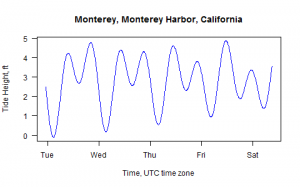

Most people know that the tides have something to do with the moon, its gravitaional pull and its phase, and that the greatest tidal ranges are associated with full and new moons. Other parts of the world may have diurnal tides, one high and one low a day, or semidiurnal tides with two highs and two lows of equal size.
#NETARTS TIDE GRAPH SERIES#
We may also notice that there is a series of low tides about every two weeks or so, usually the lower of the two lows in the morning (AM) during the summer and in the evening (PM), usually after dark, during the winter. If we look at the times of the tides on successive days, such as the AM high tides in December, we find that they occur later from one day to the next. and P.M., and that there is a higher high and a lower high and a higher low and a lower low, a phenomenon called “mixed tides.” The favored minus tides (those below the mean of lower low water which is designated as the “zero level”) are highlighted in red. We can see from the these pages that there are usually two high tides and two low tides each day, A.M. Reproduced here are tide tables for June 2005 and December 2005.

Where do all these times and values come from and what do they really mean? We will try to provide some answers. Most of us take these tables on faith with only a little understanding of the processes behind them. Here we find the dates, times, and levels of tides. and distributed to local stores and other outlets. Low tides leave isolated tide pools that let us discover the biological zones that cover the vertical faces of rocks, where starfish prey on mussels living just above them, and green anemones show their faces to young children who gently poke fingers into their mouths and feel the tingle of tentacles that close around them.īefore heading to the shore, we often examine tide tables corrected for Tillamook County beaches, published locally by Coast Printing & Stationary, Inc. No heavy pulling or long wait times! They are available for purchase at most local stores.A favorite time for both locals and visitors to explore the seashore is at low tide when the ocean recedes to reveal the myriad of animals and seaweeds that inhabit the sand and rocks, life that is otherwise hidden from view. A good tool to try is the “castable folding crab trap.” Usually attached to a fishing pole, these traps are great for kids because they are lightweight and can catch crab within minutes. Crabbing is currently poor to fair out of Depoe Bay, Newport and Waldport.Įven though crabbing is slow, don’t let that stop you from the fun of trying! Shore and dock crabbing can be great activities as our weather starts to improve. We usually have to wait until late June and into July for size and abundance to increase. As a result of molting, crabs get bigger and legal to keep. May tends to be a slower month for crabbing while we wait for their migration into the bays for molting.

Recreational crabbing (ocean, bays, estuaries, beaches, docks, piers) is CLOSED from 8 miles north of Winchester Bay (Tahkenitch Creek 43☄7’) to Cape Blanco (42★0’) due to elevated levels of domoic acid. See the map on the Regulation Updates page above. Always call the ODA shellfish safety hotline at 1-80 or ODA shellfish closures website before harvesting for the most current information about shellfish safety closures. Razor clamming remains closed from Tillamook Head to the California border due to toxin levels. Razor clams are OPEN from the Washington border to Tillmook Head at 12:01 a.m. Īlways call the ODA shellfish safety hotline at 1-80 or ODA shellfish closures website before harvesting for the most current information about shellfish safety closures. You can also get more clamming maps here. Monitor the weather forecast and the swell and surf advisories before going out to make sure you can safely clam.Ĭheck out the Where to Clam articles for places to find bay clams. As negative tides switch from night to daytime, clammers should use caution when visibility is low. With the arrival of spring, bay clamming opportunities increase with early morning low tides. Open-ocean and bay crabbers must mark their buoys. Submit your fishing photo to ODFW and we might use it here or elsewhere on .Īlways check for closures at the ODA Shellfish Safety page before harvesting shellfish, which includes clams, crabs and mussels. "First Keeper! Crabbing in Newport -Photo by Anthony Hatch.


 0 kommentar(er)
0 kommentar(er)
